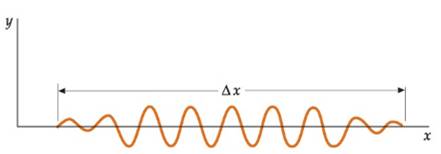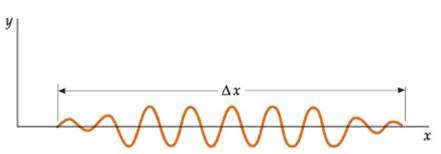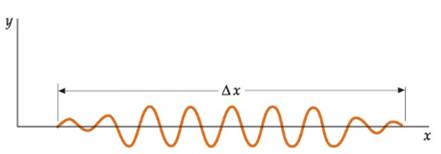
Concept explainers
(a)
The range ofwavenumber.
(a)
Answer to Problem 67P
Explanation of Solution
Introduction:
A sound wave form originated by tuning fork of frequency centered on

Figure 1:A sound waveform created by a tuning fork
Basically, the wave packet is the result of the superposition of the two or more waves, hence, the resultant of the super-position of the wave results in the spread of frequencies,
Let say, the v is the speed of the pulse. Therefore, the pulse spread in space can be written as
The range of frequencies
As it is well known relation between the velocity, frequency and the wave number is
Putting the value of v from equation 1 in equation 2,
Comparing equation 1 and 4, we get
k is the wave number.
Conclusion:
The wave number range is
(b)
The average value of the wavelength.
(b)
Answer to Problem 67P
Explanation of Solution
Introduction:
A wavelength
N number of cycles are there in a wave packet of length
The distance for one cycle is basically equal to the wavelength and will be
Hence, one can write
Conclusion:
The average wavelength will be
(c)
The average value of the wave number k
(c)
Answer to Problem 67P
Explanation of Solution
Introduction:
As calculated before:
N number of cycles are there in a wave packet of length
The distance for one cycle is basically equal to the wavelength and will be
Hence,
The relation between
From equation 3:
Conclusion:
The average value of the wave number kis
(d)
Therange in angular frequencies.
(d)
Answer to Problem 67P
Explanation of Solution
Introduction:
A sound wave form originated by tuning fork of frequency centered on

Figure 1:A sound waveform created by a tuning fork
Basically, the wave packet is the result of the superposition of the two or more waves, hence, the resultant of the super-position of the wave results in the spread of frequencies,
The relation between the range of frequencies
Conclusion:
The range in angular frequencies
(e)
The frequency in terms of N and
(e)
Answer to Problem 67P
Explanation of Solution
Introduction:
A sound wave form originated by tuning fork of frequency centered on

Figure 1:A sound waveform created by a tuning fork
Basically, the wave packet is the result of the superposition of the two or more waves, hence, the resultant of the super-position of the wave results in the spread of frequencies,
N number of cycles are there in a wave packet of length
The time required to complete one cycle is basically equal to the frequency and will be
Hence, one can write
Conclusion:
The frequency will be
(f)
The uncertainty in N.
(f)
Answer to Problem 67P
There is an uncertainty of
Explanation of Solution
Introduction:
A sound wave form originated by tuning fork of frequency centered on

Figure 1:A sound waveform created by a tuning fork
Basically, the wave packet is the result of the superposition of the two or more waves, hence, the resultant of the super-position of the wave results in the spread of frequencies,
As it is clear from the Figure 1, there is a cycle which is not a complete one. Hence, the cycle can be either not present or may be present in the wave packet.
Therefore, there is an error or uncertainty of
Conclusion:
There is an uncertainty of
(g)
The uncertainty in wave number k
(g)
Answer to Problem 67P
Explanation of Solution
Introduction:
A sound wave form originated by tuning fork of frequency centered on

Figure 1:A sound waveform created by a tuning fork
Basically, the wave packet is the result of the superposition of the two or more waves, hence, the resultant of the super-position of the wave results in the spread of frequencies,
As calculated before:
N number of cycles are there in a wave packet of length
The distance for one cycle is basically equal to the wavelength and will be
Hence, we can write
The relation between
From equation 3 we obtain
As calculated by the previous section that the uncertainty in N is
Conclusion:
The uncertainty in k will be,
Want to see more full solutions like this?
Chapter 16 Solutions
Physics for Scientists and Engineers
- (a) If a submarine’s sonar can measure echo times with a precision of 0.0100 s, what is the smallest difference in distances it can detect? (Assume that the submarine is in the ocean, not in fresh water.) (b) Discuss the limits this time resolution imposes on the ability of the sonar system to detect the size and shape of the object creating the echo.arrow_forwardA sound wave is modeled as P=1.80Pasin(55.41m1x18,840s1t) . What is the maximum change in pressure, the wavelength, the frequency, and the speed of the sound wave?arrow_forwardA bat sends of a sound wave 100 kHz and the sound waves travel through air at a speed of v=343 m/s. (a) If the maximum pressure difference is 1.30 Pa, what is a wave function that would model the sound wave, assuming the wave is sinusoidal? (Assume the phase shift is zero.) (b) What are the period and wavelength of the sound wave?arrow_forward
- A string has a linear mass density µ, a length L, and a tension of FT, and oscillates in a mode n at a frequency f. Find the ratio of ff for a small change in tension.arrow_forwardCheck Your Understanding The equations for the wavelengths and the frequencies of the modes of a wave produced on a string: n=2nLn=1,2,3,4,5...andn=nv2L=nf1n=1,2,3,4,5... were derived by considering a wave on a string where there were symmetric boundary conditions of a node at each end. These modes resulted from two sinusoidal waves with identical characteristics except they were moving in opposite directions, confined to a region L with nodes required at both ends.Will the same equations work if there were symmetric boundary conditions with antinodes at each end? What would the normal modes look like for a medium that was free to oscillate on each end? Don’t worry for now if you cannot imagine such a medium, just consider two sinusoidal wave functions in a region of length L, with antinodes on each end.arrow_forwardConsider a sound wave moving through the air modeled with the equation s(x,t)=6.00nmcos(54.93m1x18.84103s1t) . What is the shortest time required for an air molecule to move between 3.00 nm and -3.00 nm?arrow_forward
- Design a 5th order active filter showing all the design steps, assumptions made and necessary calculationsThe threshold frequency = 12kHz.The speaker is supposed to reject all sounds having a frequency below a certain threshold which is 12kHzarrow_forwardDraw the first five standing wave harmonics in a string of length L = 2 m with tensionT = 90 N and density µ = 10 kg/m. What are the wavelengths λn and frequencies fnfor each of these harmonics?arrow_forwardFigure 17-37 shows a transmitter and receiver of waves con- tained in a single instrument. It is used to measure the speed u of a target object (idealized as a flat plate) that is moving directly toward the unit, by analyzing the waves reflected from the target. What is u if the emitted frequency is 18.0 kHz and the detected frequency (of the returning waves) is 22.2 kHz?arrow_forward
- As the number of people at a party increases,you must raise your voice for a listener to hear you againstthe background noise of the other partygoers. However, once youreach the level of yelling, the only way you can be heard is if youmove closer to your listener, into the listener’s “personal space.”Model the situation by replacing you with an isotropic point sourceof fixed power P and replacing your listener with a point that absorbspart of your sound waves.These points are initially separatedby ri=1.20 m. If the background noise increases by b=5 dB, thesound level at your listener must also increase.What separation rfis then required?arrow_forwardA wave traveling on a string hes the following wave function , y(u, ) = A sin (kutwt +q At time X=0 has and is mouing in the negative yu diretion the the point x dis placement of %3D what is the phase constant and wave speed direction?arrow_forwardA crude approximation of voice production is to consider the breathing passages and mouth to be a resonating tube closed a one end. What is the fundamental frequency fi if the tube is 0.200 m long, by taking air temperature to be 37.0 °C? What would this frequency become if the person's breathing passage were filled with hydrogen instead of air? Assume the same temperature dependence for hydrogen as for air. ZH fı,hydrogen %3D Question Credit: OpenStax College Physicsarrow_forward
 University Physics Volume 1PhysicsISBN:9781938168277Author:William Moebs, Samuel J. Ling, Jeff SannyPublisher:OpenStax - Rice University
University Physics Volume 1PhysicsISBN:9781938168277Author:William Moebs, Samuel J. Ling, Jeff SannyPublisher:OpenStax - Rice University Classical Dynamics of Particles and SystemsPhysicsISBN:9780534408961Author:Stephen T. Thornton, Jerry B. MarionPublisher:Cengage Learning
Classical Dynamics of Particles and SystemsPhysicsISBN:9780534408961Author:Stephen T. Thornton, Jerry B. MarionPublisher:Cengage Learning

